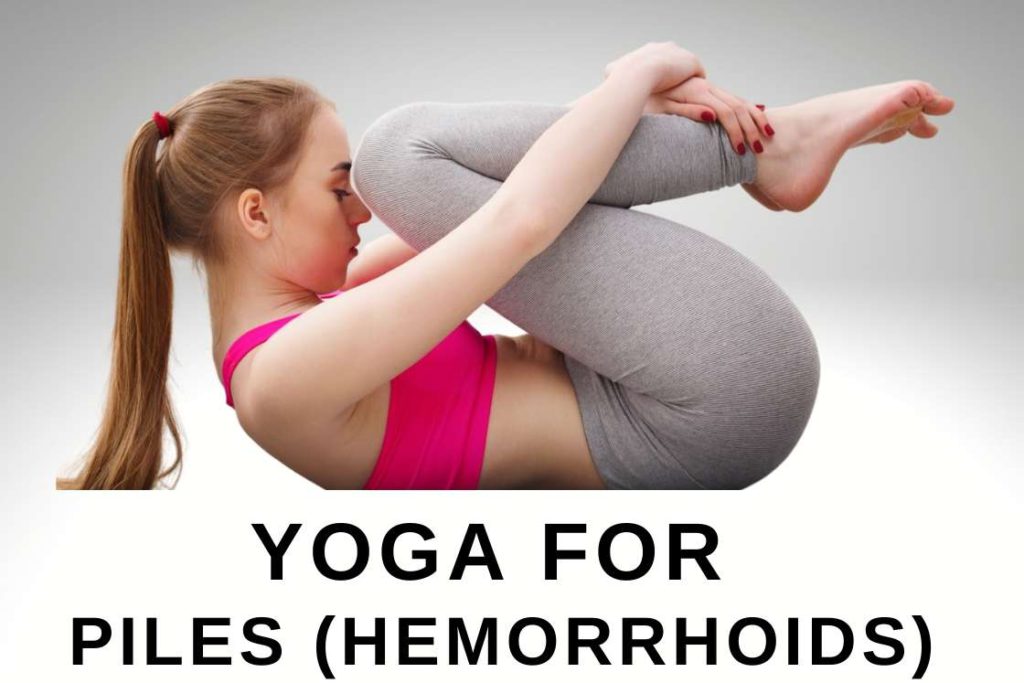
Some cases of piles do resolve on their own, some turn into a chronic condition. In such conditions, yoga can help bring lifestyle changes to treat piles and prevent swollen veins located around or in your anus.
Regulating the lifestyle has always been the preferred way of managing piles. Healing your body with yoga, designing a diet that improves your digestive health, and encourage regular bowel movements will prove to be the best medicine in piles.
Identifying piles
Although many cases of piles resolve on their own, still, if you have even the starting hints of piles, you better start preparing. Even mild conditions are known to progress into chronic. And, obviously, mild conditions are easily managed. If you already are in the chronic phase then lifestyle changes are what even doctors will recommend you.
Identification of piles [efn_note] The nature of piles https://www.ncbi.nlm.nih.gov/pmc/articles/PMC1500096/pdf/bmjcred00628-0006.pdf [/efn_note] is a bit tricky in mild conditions. Most people having mild piles, won’t even know. This is why it is important to evaluate your bowel movement in order to determine if you have piles or not [efn_note] internal piles: diagnosis and treatment https://www.ncbi.nlm.nih.gov/pmc/articles/PMC2531307/pdf/postmedj00890-0012.pdf [/efn_note]. And, if you do then start with your lifestyle changes right away before it gets chronic.
Check for bright red blood or slimy mucus in your feces; dark or tarry black feces is not a sign of piles. If you can feel a lump around your anus, if you have an itchy anus or if you have a painful anus. And, finally often unable to empty your bowels at one to two attempts.
Will yoga benefit you?
Heavy-weight exercises are not your cup of tea if you have piles. Thus, restorative physical activities like Tai-Chi and Yoga could be your natural solutions for piles treatment.
Yoga is widely popular for its poses and breathing exercises that deal with the abdomen muscles and organs. It benefits piles by regulating bowel movements and cleansing the colon through shatkarma techniques.
Most yoga exercises you come across will have some degree of digestive benefits whilst some will exclusively care for your abdominal functions. For example, Ashwini yoga mudra is a wonderful exercise for piles as it contracts & releases anus sphincter muscles, thus strengthening them.
Yoga poses twist and flex the abdomen muscles for a better performance of the organs and squeeze the glands for balanced hormone secretion. These benefits coupled together provide wonderful management of piles.
Moreover, to relieve tense muscles and nerve pain in piles, yoga also provides therapeutic relaxation and reduces your suffering. Finally, piles take a toll on psychology as well. The meditative nature of yoga is very useful in calming the mind and keeping you stress-free.
Yoga Poses for Piles (Hemorrhoids)
Not all yoga poses are doable in piles. You should always be precautionary about choosing a specific pose when suffering from a physical condition.
These 7 yoga poses and pranayama can help treat and prevent piles (hemorrhoids).
1. Garland Pose (Malasana)
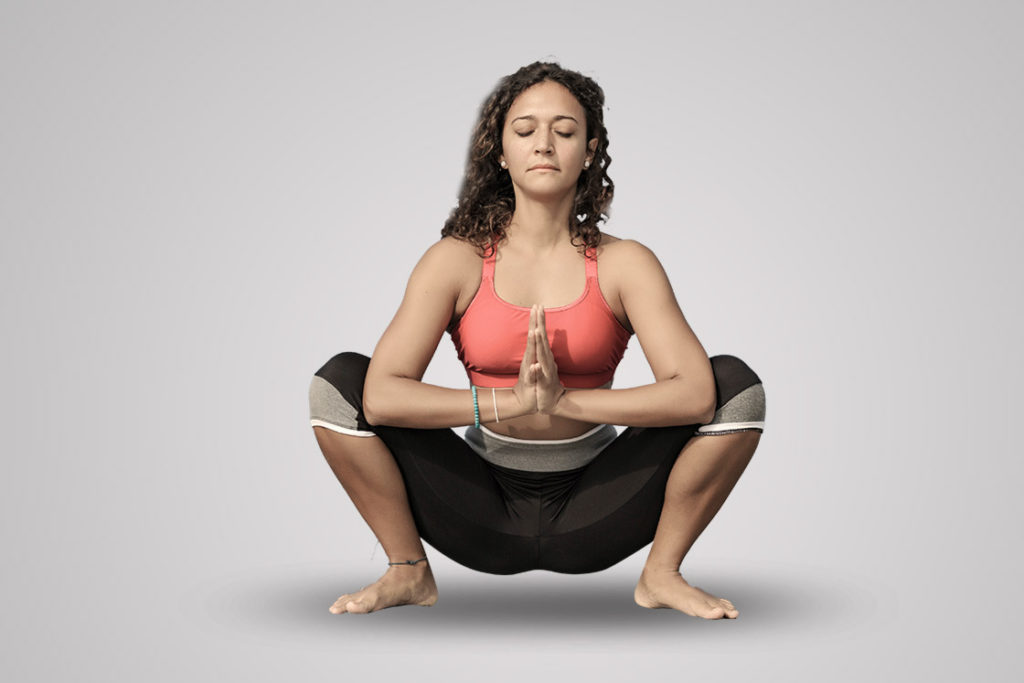
Garland pose is a signature yoga pose for people with piles. It prepares your bowels for a smooth a seamless movement to pass stool, relax your anal sphincter, and prevent straining. You can practice this pose right before going to relieve yourself in the bathroom.
Malasana also benefits your entire pelvic floor. To relieve piles’ pain, it stretches your back, groin, and ankles. Moreover, it also facilitates bowel movement and digestion.
- Stand straight, with your feet wider than your hips’ length.
- Point your feet slightly outward, and sit down for a squat.
- Keep your head and spine straight and do not bend forward.
- Keeping going lower, till you are completely seated in a squat.
- Once completed seated, you can keep your hands on your knees, or join them in a Namaste.
- Look ahead, breathe steadily and hold the pose for 4-5 minutes.
- Touch the ground, take support, sit on your back and come out of the pose.
Note – Wear kneecaps for garland pose to protect your knees. If at any time you feel an unnatural strain on any part of your lower body, feel free to support with your hands on the floor and reduce the tension. While getting out of the pose, only do so by sitting on the ground. Do not attempt to directly stand up from the squat.
2. Child’s Pose (Balasana)
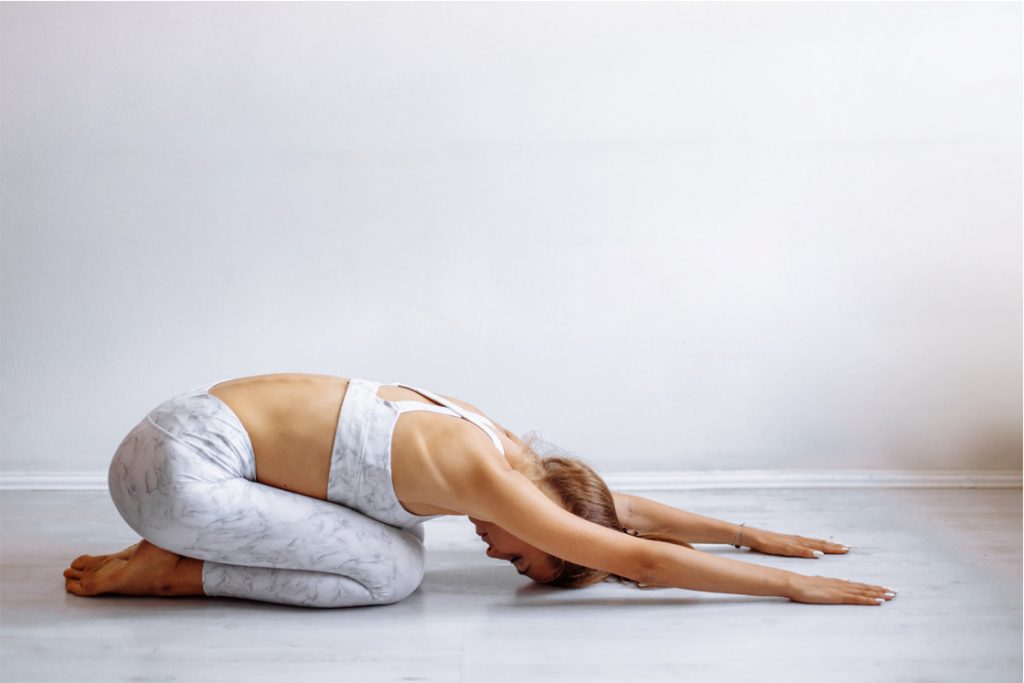
This pose stretches the lower back muscles and digestive tracts which can be helpful in piles. It increases circulation around your anus and relieves constipation while relaxing your hips and legs.
Child’s pose is said to provide a massage to your internal organs by increasing blood flow to the inflamed areas of your digestive and anal system. This way, it improves blood circulation can help with soreness and pain.
- Sit on folded knees. Let the top of your feet rest on the floor with your heels supporting your sitting bones. Much like a Vajrasana pose.
- Rest your chest on your knees, as you bend forward.
- Look at the floor and keep your head low.
- Stretch your arms out Infront -as far as possible.
- Gently rest your head on the floor. And keep your buttocks slightly lifted.
- Gently breathe till you feel your lower back puff up like a dome. And, exhale to feel the dome collapse.
- You can hold this pose for a couple of minutes.
Note – Using a kneecap with this pose will prove beneficial to your knees as well and so will a pair of anklets. If you have a sore back from piles, don’t sit on your heels. Rather, place a folded blanket or a yoga block between your feet and sit on it.
3. Head to knee pose (Janu sirsasana)
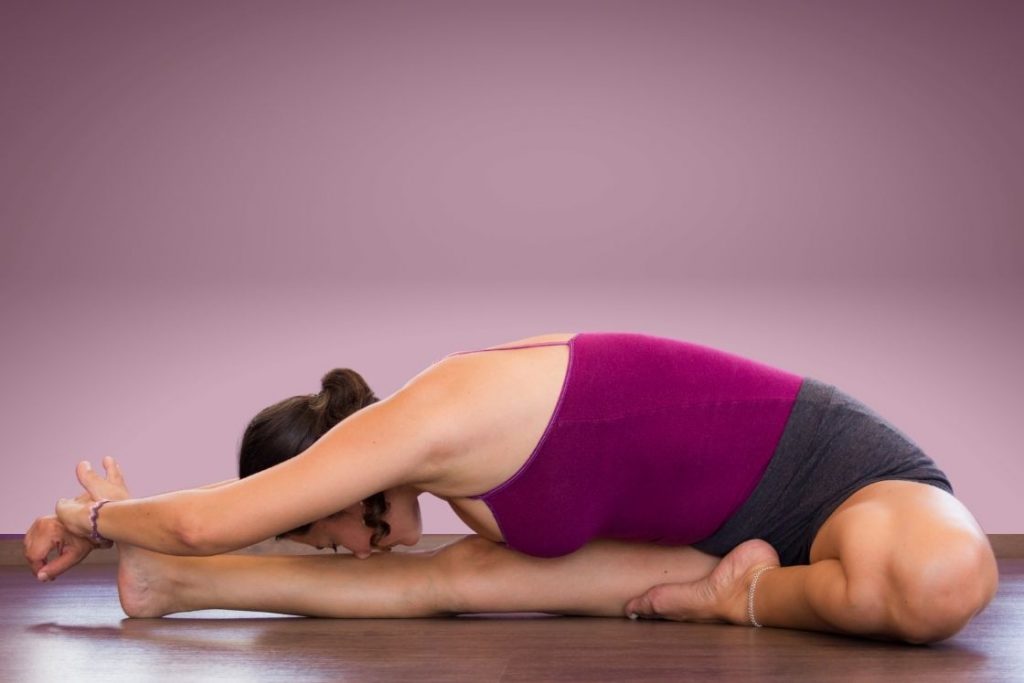
Janushirasana is a versatile yoga with a great range of benefits. For people with piles, janu sirsasana will provide very specific benefits. This pose will strengthen your back and abdomen muscles. And strong abdomen and anal muscles are less likely to get injured and inflamed.
Janu sirsasana will also boost your digestive functions, reduce belly fat, stimulate adrenal hormones, improves cardiovascular, kidney, and liver functions, and improves blood circulation. It also regulates stress hormones to manage anxiety levels.
- Sit on your sitting bones on the floor, with both the legs stretched straight in front. Keep your spine, back and head straight.
- Bend the right knee, fold and bring it close to your groin and set it against your upper-inner thigh.
- Keeping your spine as straight as possible, collapse your belly and bend your upper body forward and downward.
- Touch your knee with your head and inhale.
- Reach out for your left foot with both your hands and exhale.
- Do this pose for 3-4 repetition
Note – While bending and stretching with your upper body, initially do not force yourself too hard. Let your body gradually develop flexibility. More specifically for piles, do not sit directly on the mat. Use a towel or a blanket to circle it into a cushioned seat, and then sit on it. This will give your sore buttock muscles some support
4. Wind Relieving Pose (Pawanmuktasana)
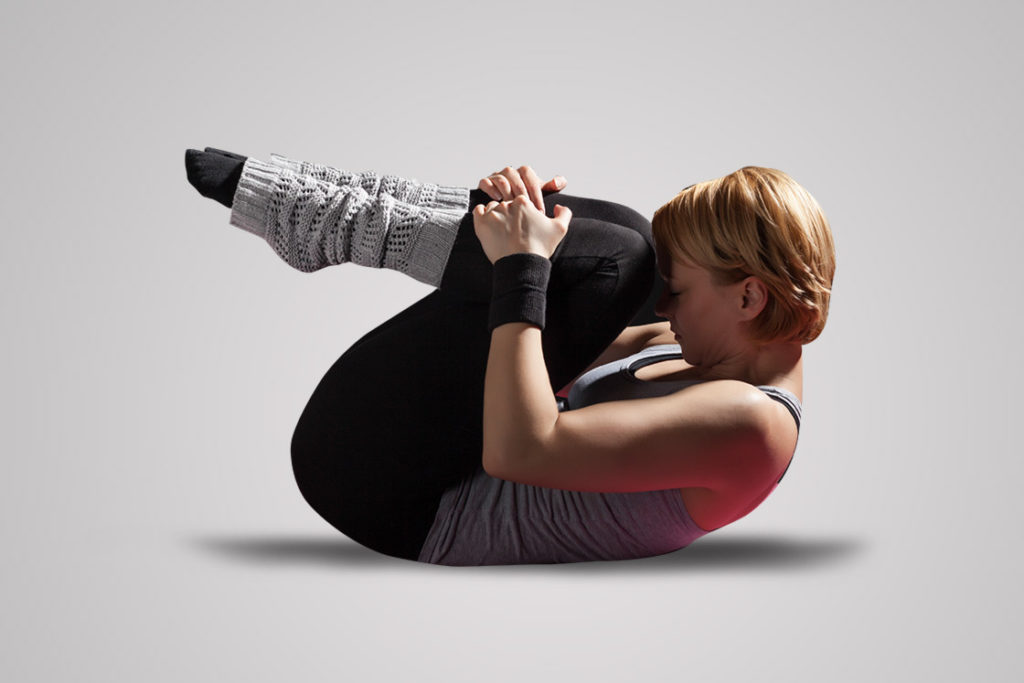
Pavanmukhtasana is a highly recommended pose for piles. As the name suggests, this pose works perfectly to relieve gas which is a potential pile threat.
Pavanmukhtasana squeezes and flexes your abdominal muscles. This action activates your pelvic floor muscles and stretches your lower back. This asana compresses and extents your abdominal and anal, tracts and organs in such a way, that it rids your system of all the unnecessary gas.
- Lie straight on your back, with your arms by your side.
- Join your thighs, knees and feet. Point and Stretch out your feet downward.
- Bend and fold your knees, to bring them close to your body and touch your chest. Although, your knee join won’t touch your chest, rather the part where your thighs meet your knee.
- Put your arms around your shin bone, and clasp your hands together -to press down your knees against your chest. Try and pull down your knees a bit.
- Inhale and lift your head to bury it in between your knees, and exhale
- Hold your breath for 4-5 breaths and release your pose. Repeat the asana for about 10 times.
Note – Initially don’t pull your knees too hard. If at any point it feels to strain your buttock muscles or abdominal muscles, do not pull harder. Also use support below your head, so that on the release you don’t need to take your head all the way back to the floor. This will save your neck from injury.
5. Half Lord of the Fishes Pose (Ardha Matsyendrasana)
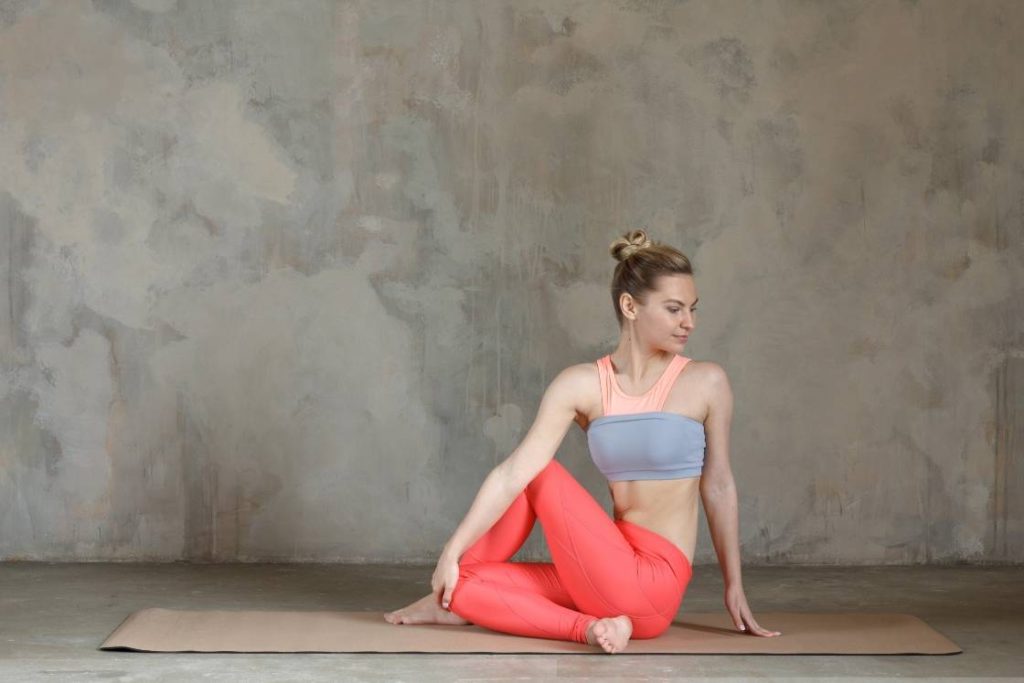
Ardha Matsyendrasana is a very unique pose, both in terms of its looks and benefits. This is the perfect asana to heal any imbalance in the abdomen which gives birth to piles.
Twisting your abdominal muscles and spine, Ardha Matsyendrasana relieves all digestive muscles, tones them, and reduces your belly fat. This pose increases the range of motion of your spine and strengthens the muscles supporting the spine. Practicing this yoga pose, will also give you a better sitting posture and counterbalance the negative effects of a sedentary lifestyle. Finally, Ardha Matsyendrasana improves the bowel movement in the lower abdomen to relieve constipation.
- Sit up straight, with your legs stretched and straight Infront. Keep your spine erect and feet together.
- Break your left, and draw your knee close to your pelvis, across the ground, and place your left heel against your right thigh.
- Hold your right shin bone with your right hand, and pull it up to bend your knee.
- Now put your right leg over your left knee, such that your right heel is touching the top of your left knee.
- Now hold your right knee with your left hand and draw it towards your body, and at the same time, twist your torso and upper body towards right.
- Keep your head, spine and shoulders straight. Look ahead on your right side. And place your right hand on the floor behind your back, and lock your position.
- Hold your pose for a couple of breath and turn front.
- Gently open your legs, and stretch out both legs. Repeat the same on the other side.
Note – To ease the soreness of piles, use a rolled and circled-up towel, under your sitting bones. When turning on right ( or left ) side don’t pull your right knee ( or left knee ) too hard, and don’t twist your spine more than 90 degrees.
6. Basti Kriya
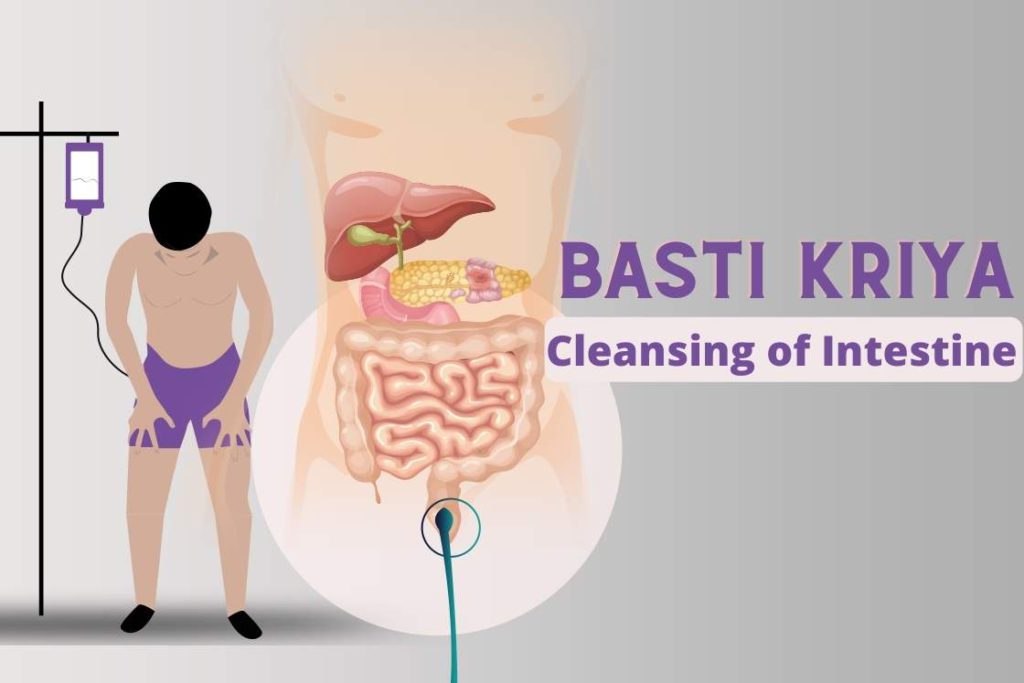
Basti kriya, also known as yogic enema, is one of the most effective shatkarma yoga practice for piles treatment.
In this kriya, the water is sucked into the rectum from a water source like (pond or bucket) using a bamboo or lotus stem. It cleanses the colon and removes impurities of the anus.
Read here: How to Do Basti Kriya
7. Diamond Pose (Vajrasana)
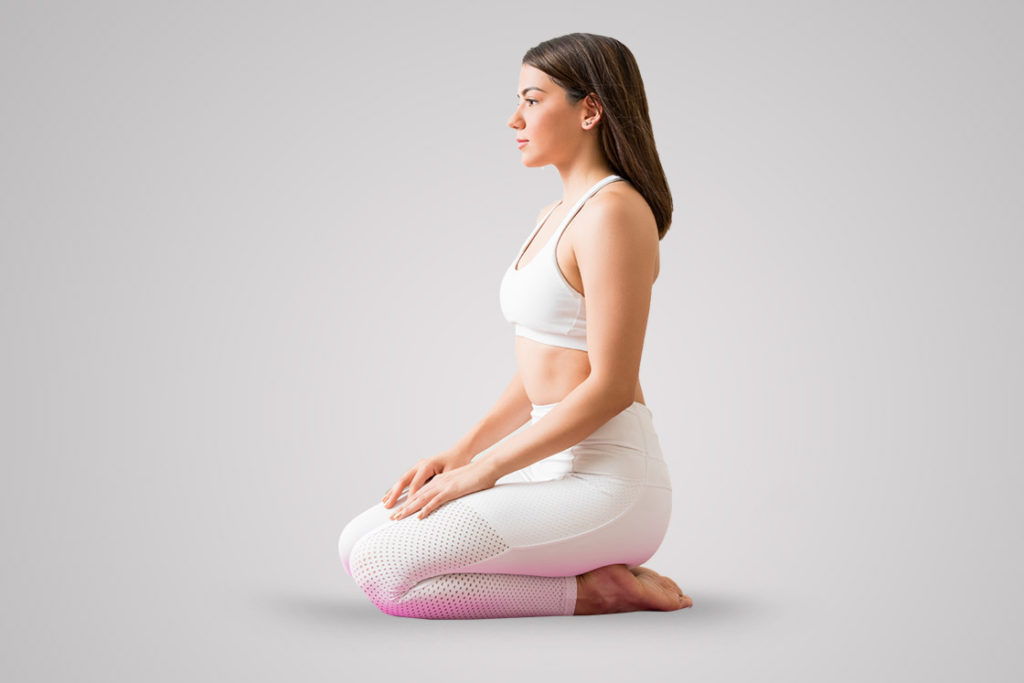
Vajrasana is a simple yet effective pose. This pose is great for digestion and can be tried post meals. Vajrasana stretches your buttocks, lower back, which will provide relief to soreness and muscle traumas. It also extends your upper and lower abdominal tracts for better food and bowel movement.
Vajrasana also improves blood circulation in your abdominal and pelvic region. The diamond pose is also known to benefit knee joints, ankle and hip.
- Kneel on the floor on your knees.
- Join your thighs, knees and feet.
- Let the upper part of your feet touch the floor.
- Stretch out and point your big toes inwards, and touch each other.
- Keep your spine and head straight.
- Bend forward and sit on your heels.
- Let your feet press down and outwards, as the carry the weight of your body.
- Place your palm on your knees.
- Look straight and hold the pose for atleast a minute. Once comfortable, you can go upto 5 minutes.
Note – Use a yoga block or roll blanket between your feet to sit on. This will help with your piles. And if extreme pressure builds in your ankles or knees, use your hands as support. Press down on the floor on both sides, with your hands, lean forward and lift up your buttock from the heels and release a bit of tension. Once comfortable, move back to Vajrasana.
8. Kapalabhati Pranayama
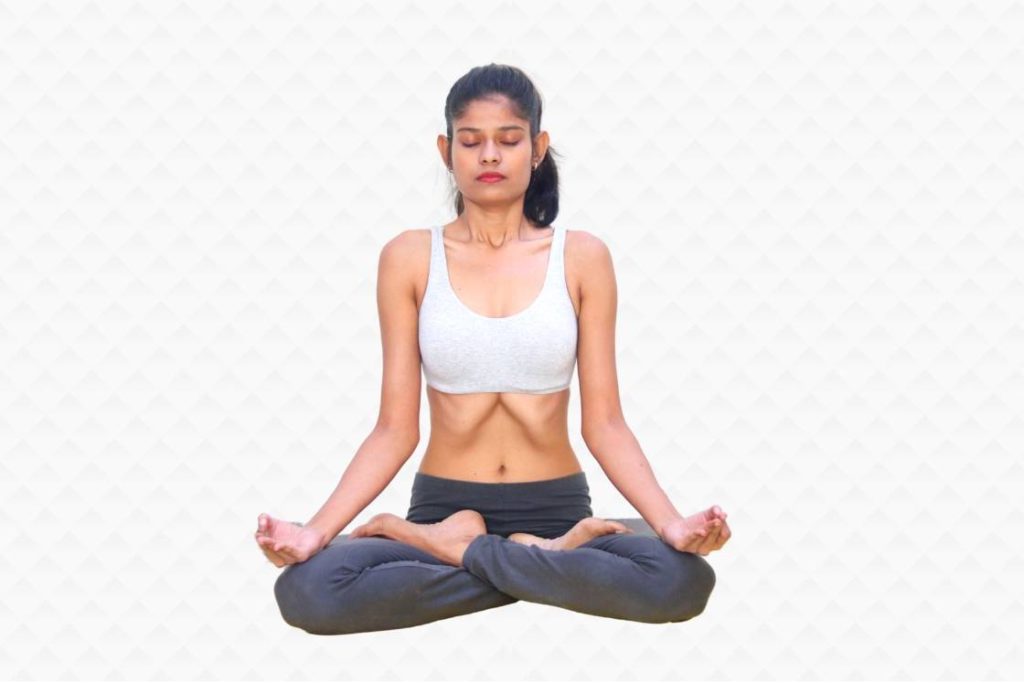
Although, most Pranayamas are popular for their respiratory and cardiovascular significance, Kapalabhati is equally boosting for your abdomen as well.
Kapalabhati uses swift successive bursts of muscle contraction in the abdominal, which effectively releases all tension in the region. It also activates the glands in the abdomen for balanced hormone secretion. Hormones that aid in digestion. It also works up the bowel tracts in the lower abdomen for an obstructed movement.
- Sit comfortably in a cross-legged position, with your spine erect, head straight and shoulder blades open.
- Place your hands on the knee, with the palm facing upwards.
- With a strong pull of the abdomen, take a deep breath in.
- Now make a small construction in your abdomen muscles, to push out the air from your lungs in a spurt.
- Without taking any more deep breath, make around 20 such successive, exhaling breath spurts.
- You can do 5 rounds of such 20 exhalation spurts. While pacing each round with a gap of 10-20 secs.
Note – For convenience in piles, sit on a cushioned chair for kapalbhati. Although, not a very lavishly cushioned chair, as that can interfere with the posture. Once you run out of the initially inhaled air, on a deep breath, the following inhalation will come naturally with the contraction and relaxation of your abdominal muscles. Your focus should primarily be on the exhalations spurts. Also, don’t go for a very deep breath in the initial inhale.
What lifestyle changes you need to make for piles
Management of piles [efn_note] management of piles https://www.ncbi.nlm.nih.gov/pmc/articles/PMC1500162/pdf/bmjcred00629-0007.pdf [/efn_note] needs three main areas to focus on physical workout, selective eating, and the timing of everything you do in a day.
1. Diet
Since most piles are developed from either chronic constipation or chronic diarrhoea, every pile’s management plan starts with the selection of food. As certain foods will help to relax the condition, some will tend to aggravate it. Foods that will help you with your piles are:
- squash, pumpkin.
- Cruciferous vegetables -broccoli, cauliflower
- Root vegetables -sweet potatoes, turnips, carrots,
- Cucumbers, apples, bananas and melons
- Unsweetened curd
- Legumes – beans, lentils, peas, soybeans
- Whole grains – rice, oats, corn and barley
Also, add a healthy amount of unsweetened fluid -it’s a must. On the other hand foods that are a big no-no if you have piles are-
- Rich dairy products
- Red meat
- fried food
- processed meat
- white flour
- Alcohol and caffeinated beverages
2. Routine and healthy habits
When having piles it is important to follow a fixed routine and develop healthy habits [efn_note] painful piles http://nopr.niscair.res.in/bitstream/123456789/21182/1/SR%2050%289%29%2046-47.pdf [/efn_note]. If you have piles, your bowel systems will be bad at quick adjustments to sudden food and routine changes. Thus it is important for you to follow a rough routine. Additionally, some unhealthy habits can spoil matters for you as well. For example, having a rich meal at a late dinner will make a disaster of your digestion. Which will eventually aggravate your piles
- When having piles, it is advisable not to eat too much at once -rather, eat small portions but frequently.
- Don’t combine foods that can cause acid reflux.
- Don’t eat excessive highly sweetened food, it irritates the digestive tracts.
- Try to avoid rich food for dinners, late or early.
- Avoid smoking and caffeinated drinks on an empty stomach.
- Keep your protein and fiber intake average.
- Use clean underwear regularly.
- Give your body sufficient rest, wake up early and go to bed early.
- Do not withhold your bowels, go to relieve bowels as many times as you need to.
- Do not lift heavy weights and avoid heavy exercises, especially of the abdomen.
- Don’t strain your anus while defecating.
- Meditate to calm your minds and nerves.
- To not sit, walk or sleep in bad postures.
- Try to avoid a sedentary lifestyle. If you have a desk job, try to take frequent but tiny breaks and walk your legs a bit.
3. Physical activity
The 21st century is ripe with slouching on a couch. The sedentary lifestyle [efn_note] Boston medical and surgical journal https://www.nejm.org/doi/pdf/10.1056/NEJM183608240150301 [/efn_note] is at its peak, now more than ever. In such times, digestive disorders and related issues are only common. A study estimated that 16 out of 100 adults [efn_note] Chronic constipation https://www.ncbi.nlm.nih.gov/pmc/articles/PMC5976340/ [/efn_note], on an average, suffer from constipation worldwide. Re-thinking and re-defining physical activities at this juncture are crucial to the well-being of our future.
When you need to avoid physical exercises, yet you need to remain physically active, you need to consider.
- Yoga
- Any simple freehand exercise
- Tai-Chi
- Pilates
- Swimming
- Callanetics
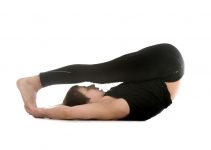
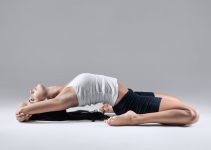

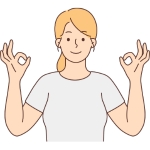
 Oct 24th to 30th
Oct 24th to 30th Learn Mudras
Learn Mudras  Deepen Your Practice
Deepen Your Practice  Find Inner Peace
Find Inner Peace